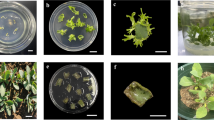Summary
Tissue browning that frequently results in the early death of bamboo shoots in vitro correlated directly with polyphenol oxidase (PPO, EC 1.10.3.1) activity and inversely with titratable acidity. It was unrelated to the level of endogenous phenols. During the course of culture, timing of PPO activity paralleled that of explant browning. Browning was highest among shoots cultured in a medium of pH 8, which was consistent with the pH optinum of the bamboo enzyme. The pH optimum was first determined with the crude enzyme, then verified with two purified isozymes. Stability of the bamboo PPO was also highest at pH 10. PPO activities of the severely browning Dendrocalamus latiflorus, the moderately browning Phyllostachys nigra, and the relatively non-browning Bambusa oldhamii were inhibited strongly by ascorbic acid, cysteine, sodium diethyldithiocarbamate, and sodium sulfite. But characterization of bamboo PPO according to enzyme inhibitors was not possible because enzyme extracts of the three species gave varied responses to the traditional substances. Nutrient medium addenda of some PPO inhibitors, namely ascorbic acid, cysteine, kojic acid, and thiourea, mainly enhanced browning. However, ferulic acid at 3 mM and lower concentrations reduced the number of brown shoots per culture, although not the percentage of cultures that browned. Polyvinylpyrrolidone failed completely to suppress browning. The two purified isozymes showed different temperature optima for PPO activity: 60°C and 65°C. The purified isozymes displayed a substrate preference for dopamine, or a cathecol oxidase characteristics.
Similar content being viewed by others
References
Beruto, M.; Curir, P.; Debergh, P. Callus growth and somatic embryogenesis in thalamus tissue of Ranunculus asiaticus L. cultivated in vitro: cytokinin effect and phenol metabolism. In Vitro Cell Dev. Biol. Plant 32:154–160; 1996.
Cash, J. N.; Sistrunk, W. A.; Stutter, C. A. Characteristics of concord grape polyphenoloxidase involved in juice color loss. J. Food Sci. 41:1398–1402; 1976.
Chu, C. C.. The N6 medium and its applications to anther culture of cereal crops. In Proc. Sino-Australian Symp. Plant Tissue Culture. Peking: Science Press; 1978;43–50.
Chu, H. L., Yeh, D. B.; Shaw, J. F. The biochemical properties of polyphenol oxidase from banana leaf. Bot. Bull. Acad. Sin. 34:169–174; 1993.
Coetzer, C.; Corsini, D.; Love, S.; Pavek, J.; Tumer, N. Control of enzymatic browning in potato (Solanum tuberosum L.) by sense and antisense RNA from tomato polyphenol oxidase. J. Agric. Food Chem. 49:652–657; 2001.
Cresswell, R.; Nitsch, C. Organ culture of Eucalyptus grandis L. Planta (Berl.) 125:87–90; 1975.
Fridborg, G.; Pedersen, M.; Landstrom, L. E.; Eriksson, T. The effect of activated charcoal on tissue cultures: adsorption of metabolites inhibiting morphogenesis. Physiol. Plant. 43:104–106; 1978.
Galeazzi, M. A.; Sgarbieri, V. C.; Constantinides, S. M. Isolation, purification and physicochemical characterization of polyphenoloxidases (PPO) from a dwarf variety of banana (Musa cavendishii L.). J. Food Sci. 46:150–155; 1981.
Gould, J. H.; Murashige, T. Morphogenic substances released by plant tissue cultures. I. Identification of berberine in Nandina culture medium, morphogenesis, and factors influencing accumulation. Plant Cell Tiss. Organ Cult. 4:29–42; 1985.
Huang, L. C.; Huang, B. L.; Chen, W. L. Tissue culture investigations of bamboo—IV. Organogenesis leading to adventitious shoots and plants in excised shoot apices. Env. Exp. Bot. 29:307–315; 1989.
Jayaraman, K. S.; Ramanuja, M. N.; Dhakne, Y. S.; Vijayaraghavan, P. K. Enzymatic browning in some banana varieties as related to polyphenoloxidase activity and other endogenous factors. J. Food Sci. Technol. 19:181–186; 1982.
Jen, J. J.; Kahler, K. R. Characterization of polyphenol oxidase in peaches grown in the Southeast. HortScience 9:500–501; 1974.
Johansson, L. Effects of activated charcoal in anther cultures. Physiol. Plant 59:397–403; 1983.
Kahn, V. Polyphenol oxidase activity and browning of three avocado varieties. J. Sci. Food Agric. 26:1319–1324; 1975.
Mayer, A. M.; Harel, E. Polyphenol oxidases in plants. Phytochemistry 18:193–215; 1979.
Montgomery, M. W.; Sgarbieri, V. C. Isoenzymes of banana polyphenol oxidase. Phytochemistry 14:1245–1249; 1975.
Murashige, T.; Skoog, F. A revised medium for rapid growth and bioassays with tobacco tissue culture. Physiol. Plant. 15:473–497; 1962.
Murata, M.; Nishimura, M.; Murai, N.; Haruta, M.; Homma, S.; Itoh, Y. A transgenic apple callus showing reduced polyphenol oxidase activity and lower browning potential. Biosci. Biotechnol. Biochem. 65:383–388; 2001.
Murata, M.; Tsurutani M.; Hagiwara, S.; Homma, S. Subcellular location of polyphenol oxidase in apples. Biosci. Biotechnol. Biochem. 61:1495–1499; 1997.
Palmer, J. K. Banana polyphenoloxidase. Preparation and properties. Plant Physiol. 38:508–513; 1963.
Raghuvanshi, S. S.; Srivastava, A. Plant regeneration of Mangifera indica using liquid shaker culture to reduce phenolic exudation. Plant Cell Tiss. Organ Cult. 4183–85; 1995.
Shaw, J. F.; Chao, L. C.; Chen, M. H. Isozymes of papaya polyphenol oxidase. Bot. Bull. Acad. Sin. 32:259–263; 1991.
Snedecor, G. W. Statistical methods, 5th edn. Ames: Iowa State College; 1957; 73–74.
Tremolieres, M.; Bieth, J. G. Isolation and characterization of the polyphenoloxidase from senescent leaves of black poplar. Phytochemistry 23:501–505; 1984.
Wang, P. J.; Huang, L. C. Beneficial effects of activated charcoal on plant tissue and organ cultures. In Vitro 12:260–262; 1976.
Author information
Authors and Affiliations
Corresponding author
Rights and permissions
About this article
Cite this article
Huang, LC., Lee, YL., Huang, BL. et al. High polyphenol oxidase activity and low titratable acidity in browning bamboo tissue culture. In Vitro Cell.Dev.Biol.-Plant 38, 358–365 (2002). https://doi.org/10.1079/IVP2002298
Received:
Accepted:
Issue Date:
DOI: https://doi.org/10.1079/IVP2002298




